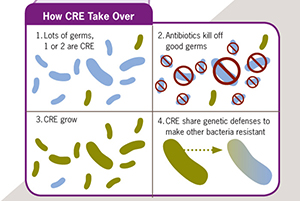Network combats ‘nightmare bacteria’

CDC is working with state public health laboratories and health care facilities to test for antibiotic resistance. Health care providers collect clinical samples and isolates, and send them to the public health laboratory for testing.
One of the most lethal of these bacteria is a drug-resistant germ called carbapenem-resistant enterobacteriaceae (CRE). CREs are on the rise and have become more resistant to last resort antibiotics during the past decade, according to a new CDC Vital Signs report. These bacteria are causing more hospitalized patients to get infections that, in some cases, are impossible to treat.
“CREs are nightmare bacteria,” said Dr. Tom Frieden, CDC Director. “Our strongest antibiotics don’t work and patients are left with potentially untreatable infections.”
The AR Lab Network launched in fall 2016 to provide infrastructure and lab capacity to detect and support response to resistant organisms recovered from human samples. The Minnesota Department of Public Health is the network’s regional lab for the central region, which includes Iowa.
“This is an excellent opportunity for the State Hygienic Laboratory to more closely align with the needs of health care providers across the state,” said Ryan Jepson, clinical laboratory supervisor. “Much of this testing is being sent out of state right now at a great cost to the patient. The Iowa Department of Public Health, the Hygienic Laboratory and the AR Lab Network should be able to greatly reduce detection time and patient costs associated with testing and treatment, and provide a much better assessment of the antibiotic-resistance threat in the state of Iowa over the coming years.”
In addition to regional lab capacity, CDC will provide support to increase capabilities to test for CRE and to perform whole genome sequencing on all Salmonella isolates for faster identification and response to outbreaks. CDC announced that this support is available for all state public health laboratories – including the State Hygienic Laboratory – and local public health laboratories in Washington, D.C., Houston, Los Angeles County, New York City and Puerto Rico.



